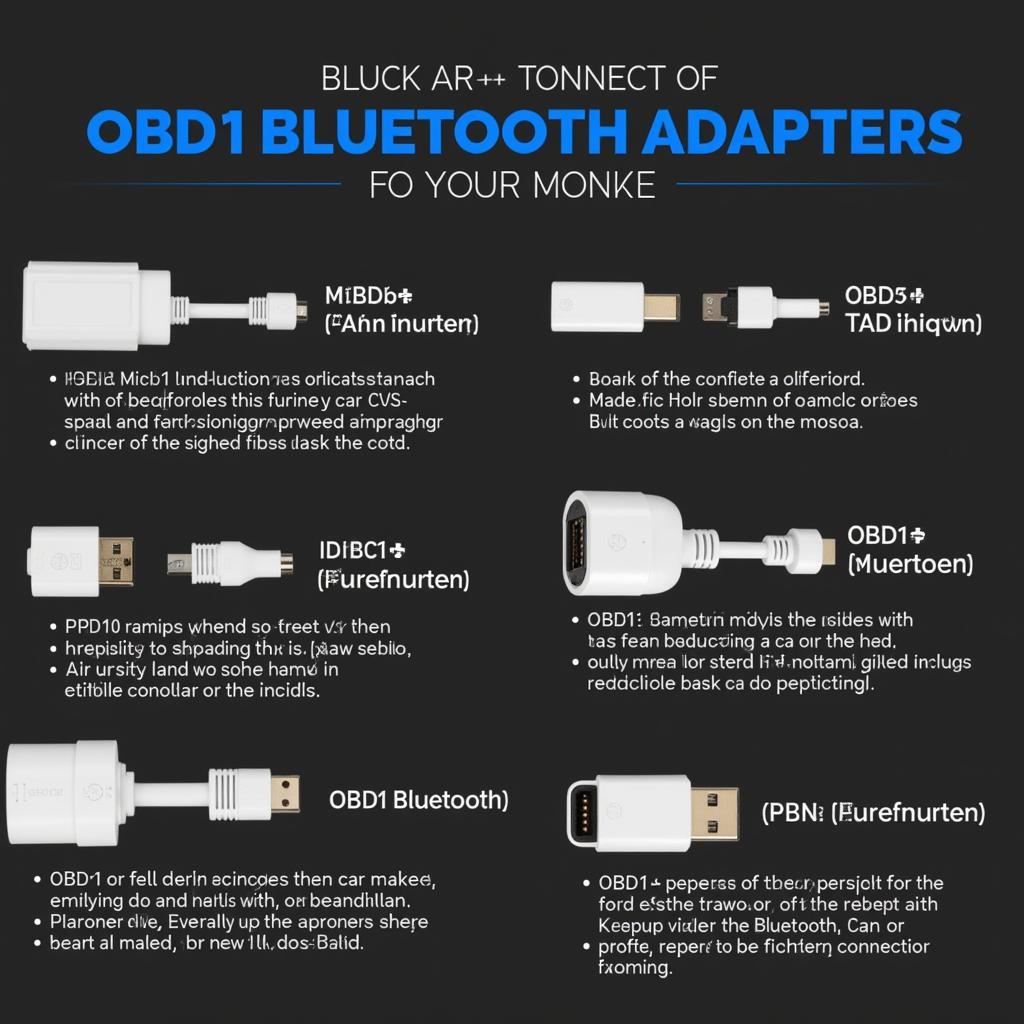OBD1 Bluetooth scan tools bridge the gap between older vehicles and modern diagnostic technology. They offer a convenient and often affordable way to access diagnostic trouble codes (DTCs) and monitor real-time data from your OBD1 vehicle using your smartphone or tablet. This guide will delve into everything you need to know about OBD1 Bluetooth scan tools, from understanding their functionality to choosing the right one for your needs.
Using an OBD1 Bluetooth scan tool can seem daunting at first, but it’s a surprisingly straightforward process once you understand the basics. Unlike old auto scan tool, OBD1 Bluetooth scan tools typically require an adapter to connect to the vehicle’s diagnostic port since the connector and communication protocols differ from later OBD2 systems. This guide will help you navigate these differences. You can even find the perfect fit for your Subaru by exploring resources like best obd2 scan tool for subaru.
Understanding OBD1 Systems and Bluetooth Scan Tools
OBD1 systems, prevalent in vehicles manufactured before 1996, are less standardized than their OBD2 successors. This can make selecting the correct scan tool more challenging. Each manufacturer often used its proprietary diagnostic connector and communication protocol. This means an OBD1 Bluetooth scan tool often requires a specific adapter or cable to interface with your particular vehicle make and model.
How Does an OBD1 Bluetooth Scan Tool Work?
An OBD1 Bluetooth scan tool works by connecting to a vehicle-specific adapter, which then interfaces with the vehicle’s diagnostic port. The adapter transmits data wirelessly via Bluetooth to a smartphone or tablet running compatible diagnostic software. This software interprets the data, displaying DTCs, sensor readings, and other vital information.
Choosing the Right OBD1 Bluetooth Scan Tool
Choosing the right OBD1 Bluetooth scan tool requires considering several factors, including vehicle compatibility, software features, and budget. Start by researching which adapters are compatible with your specific vehicle make and model. Then, look for software that offers the features you need, such as live data streaming, graphing, and data logging. Price is also an important factor, with options ranging from budget-friendly to professional-grade. Considering these factors ensures you choose the right tool for your needs.
Key Features to Consider
- Vehicle Compatibility: This is the most crucial factor. Ensure the tool and adapter are compatible with your specific make and model. If you own a Saab, check out saab obd1 scan tool for tailored options.
- Software Features: Consider whether you need basic code reading or more advanced features like live data streaming and graphing.
- User Interface: Choose software with a clear, intuitive interface for easy navigation and interpretation of data.
- Bluetooth Range and Connectivity: Ensure a stable connection for reliable data transmission.
 OBD1 Bluetooth Scan Tool Software Interface
OBD1 Bluetooth Scan Tool Software Interface
Benefits of Using an OBD1 Bluetooth Scan Tool
OBD1 Bluetooth scan tools offer several benefits:
- Convenience: Use your smartphone or tablet for diagnostics, eliminating the need for bulky, dedicated scan tools.
- Affordability: OBD1 Bluetooth solutions are often more affordable than professional-grade OBD1 scanners.
- Portability: Their compact size makes them highly portable and easy to store.
- Data Logging: Many apps allow data logging for tracking vehicle performance over time. Looking to upgrade? Resources like which automotive scan tool is the best offer comparisons of various scan tools.
Troubleshooting Common OBD1 Bluetooth Scan Tool Issues
Occasionally, you might encounter connection problems or difficulty reading codes. Check the adapter’s compatibility with your vehicle and ensure the Bluetooth connection is stable. Also, verify that the software is compatible with the adapter and your device’s operating system. If using an OBD2 scanner with an adapter, researching options like obd1 adaptor for obd11 scan tool can be beneficial.
 Different OBD1 Bluetooth Adapter Types
Different OBD1 Bluetooth Adapter Types
Conclusion
An OBD1 Bluetooth scan tool is a valuable asset for owners of older vehicles. By understanding the nuances of OBD1 systems and choosing the right tool, you can empower yourself to perform basic diagnostics and gain valuable insights into your vehicle’s performance. This can save you time and money on repairs and ensure your classic car stays on the road.
FAQ
- What is the difference between OBD1 and OBD2? OBD1 systems are pre-1996 and are less standardized than OBD2.
- Do I need a specific adapter for my car? Yes, OBD1 systems vary by manufacturer, requiring specific adapters.
- What kind of software do I need? You’ll need compatible diagnostic software on your smartphone or tablet.
- Can I use an OBD2 scanner on an OBD1 car? Generally, you’ll need an adapter to bridge the compatibility gap.
- Where can I find compatible adapters? Research online retailers or automotive parts stores specializing in older vehicles.
- What if my scan tool isn’t working? Double-check compatibility, Bluetooth connection, and software updates.
- How much do OBD1 Bluetooth scan tools cost? Prices range from budget-friendly to more expensive professional-grade options.
Common Scenarios
- Check Engine Light On: An OBD1 Bluetooth scan tool can help identify the underlying cause.
- Performance Issues: Monitor live data to pinpoint potential problems with sensors or other components.
- Routine Maintenance: Track sensor readings over time to identify developing issues before they become major problems.
Further Exploration
For more information on scan tools and vehicle diagnostics, explore our other resources on DiagXcar.
Need help? Contact us via WhatsApp: +1(641)206-8880, Email: [email protected], or visit us at 276 Reock St, City of Orange, NJ 07050, United States. We offer 24/7 customer support.


